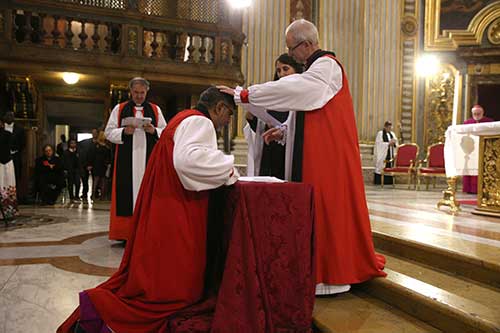
I recently received a challenge from friend, fellow blogger, and – yes – my bishop:
Let me list off all the mentions of laying on of hands in the New Testament (you can do the same research yourself for the First Testament):
Matthew 19:13, 15; Mark 5:23; 6:2,5; 8:23,25; 10:16; Luke 4:40; Acts 6:6; 8:17, 18, 19; 9:17; 13:3; 19:6; 28:8; 1 Tim 4:14; 5:22; 2 Tim1:6; Heb 6:2
Therefore let us go on towards perfection, leaving behind the basic teaching about Christ, and not laying again the foundation: repentance from dead works and faith towards God, instruction about baptisms, laying on of hands, resurrection of the dead, and eternal judgement.
Hebrews 6:1-2
Sure, there are New Testament equivalents to ordination (Acts 6:6; 13:3; 1 Tim 4:14; 5:22) and other texts follow some people’s understanding of confirmation (Acts 8:17; 19:6).
But here are some other examples of laying on hands:
Then little children were being brought to [Jesus] in order that he might lay his hands on them and pray. The disciples spoke sternly to those who brought them
The first example in the New Testament: Matthew 19:13
Then one of the leaders of the synagogue named Jairus came and, when he saw [Jesus], fell at his feet and begged him repeatedly, ‘My little daughter is at the point of death. Come and lay your hands on her, so that she may be made well, and live.’
Mark 5:22-23
[Jesus] could do no deed of power there, except that he laid his hands on a few sick people and cured them.
Mark 6:5
… and so forth…
My conclusion from this biblical survey is that the “laying on of hands” is not derived from proto-ordination and proto-confirmation but rather the other way around. Laying on of hands is a normal, biblical, natural way of expressing prayer for an individual. It has continued on in the life of the Christian church to our day. Because laying on of hands expresses prayer for an individual, hence it is appropriately used for ordination and for confirmation as well as other expressions of prayer for an individual.
Hence, it is absolutely appropriate to lay hands on the head of a person being commissioned.
Ps. I follow an essentially traditional sacramental model which includes intention clearly expressed in the verbalised prayer. A bishop, for example, doesn’t accidentally ordain someone when laying on hands if bishops are faithful to their promise to use our agreed ordinal for ordaining. If/when bishops cannot be trusted to use the authorised ordinal as agreed to in order to clearly express their intention to ordain, then the question of did they actually ordain this person or not comes into play.
Pps. There are cultural considerations, at least in the Pacific and Asia, in relation to placing one’s hand(s) on the head of another person. When, for example, a person indicates they want a prayer/blessing rather than receiving communion, my normal practice is to pray for/bless them by laying a hand on their shoulder rather than on their head. There are other considerations involved in doing so as well.
Pps. Further to the previous paragraph, there were hearsay (I never saw it myself) stories of “ordinations” without laying hands on the ordinand’s head. There were ecclesia supplet arguments that such an “ordination” actually resulted in being ordained. That debate is above my pay-grade, but if I were asked to serve on a theological committee to decide that question, I would be voting that such people be conditionally ordained at the very least.
Ppps. It is notable that this new Director of the Anglican Centre now holds this position after suspending “all communication both verbal and sacramental with both the TEC and the ACC – their Primates, bishops and clergy until such time as they reverse their theological innovations [of allowing for the fuller sacramental inclusion of gay people in a committed same-sex relationship]”. TEC, of course, would be the main source of the Anglican Centre’s funds and hence his own financial remuneration. I understand God’s ironic sense of humour to be even stronger: the building in which the Anglican Centre in Rome is located is owned by a gay man married to a man.


